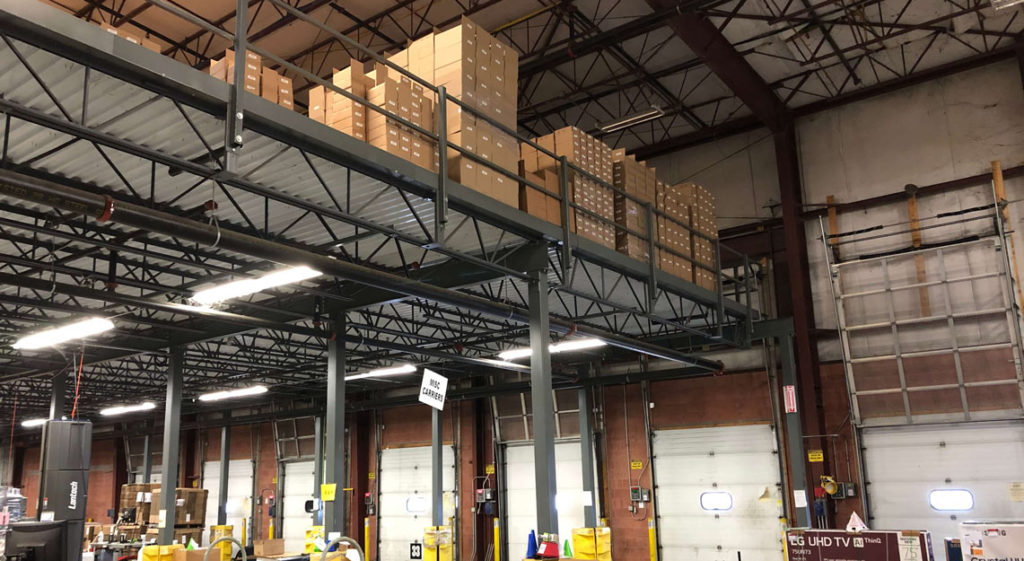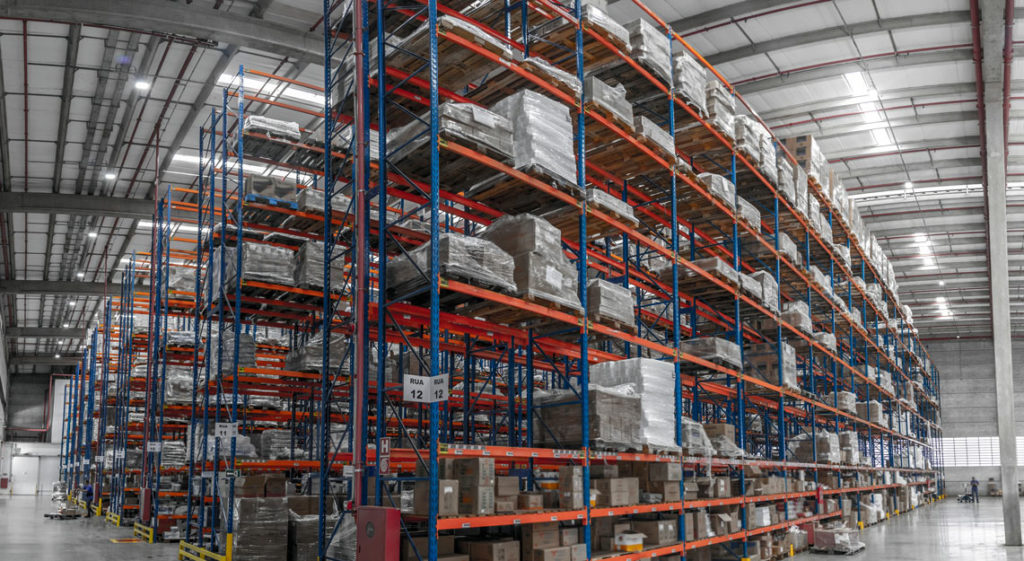10 Ways to Maximize Your Warehouse Space
After a few years of operation, you may feel as though you’re running out of room in your warehouse. While this is a frustrating problem, expanding your physical footprint isn’t the only solution. Just by taking a close look at your warehouse and implementing a few new methods, you can fully maximize your space.
Continue reading to learn more about utilizing all of the space in your warehouse.
1. Install a Mezzanine
Installing a mezzanine is a great way to vertically expand your warehouse. These platforms can be free standing or supported by shelving or racking to take advantage of underutilized vertical space.
Mezzanines are multi-use platforms. You can use a mezzanine for storing extra inventory, for warehouse managers to keep an eye on safety or for additional equipment. And if you purchase a used industrial mezzanine, you can get the added space without breaking the bank.

2. Reduce Aisle Width
If your warehouse has extra wide aisles, you may want to consider bringing your racks in. Even if you bring in the racks just a few inches, it may give you enough space for an additional row.
However, before you reduce the aisle width in your warehouse, be sure to check industry standards. According to the Occupational Safety and Health Association (OSHA), aisles should be three feet wider than the largest equipment used in that space. Typically, this results in 12- to 13-foot wide aisles.
Before you adjust your racks, measure the current aisle width and the width of your largest equipment to check against the above standards. Following safety regulations should always be of utmost importance when reconfiguring your warehouse.
3. Increase Rack Height
Most warehouses have extremely high ceilings. This means that there’s probably plenty of room to expand your shelves vertically. If your warehouse uses shorter racks, it’s time to consider purchasing taller ones — you can even find pallet racks that reach up to 45 feet tall.
If you’re struggling to figure out how tall your racks can be while prioritizing safety, utilize the height-to-depth ratio. According to the Rack Manufacturers Institute, the height-to-depth ratio compares how tall a rack is with how wide it is. If the ratio is higher than 8 to 1, you’ll need to add additional overhead support.
If you decide to purchase taller racks, keep in mind the reach capabilities of forklifts.

4. Consider Seasonal Inventory Storage
If your warehouse has seasonal inventory, you may want to consider using a temporary or underutilized storage space. If you want to get seasonal inventory completely out of the way, you can rent trailers to store those items. However, this can get pricey.
An alternative is to find a space in your warehouse that isn’t used often. Maybe there’s an inconvenient location that your workers avoid placing inventory in throughout the year. Storing seasonal inventory is also a great way to utilize a mezzanine.
5. Manage Inventory Levels
One of the best ways to maximize warehouse space is to better manage your inventory. Implementing a system that notifies workers of discontinued inventory will ensure that warehouse space is taken up by active inventory only. You most likely already have some sort of software that tells you which inventory is discontinued, old or not selling well. Use this data to better inform your physical inventory management.
Moreover, be sure to consolidate your inventory. Sometimes, workers will put pallets in the first empty space. This is great for convenience but not so much for maximizing your space. Consolidating inventory will keep pallets and picking containers full, rather than half empty and taking up much-needed space.

6. Check for Underutilized Space
Look around your warehouse. Where do you see empty space? Think about all of the places where you could add shelves and racks. For example, if you don’t already, consider adding a shelving unit around and above the shipping and receiving doors of your warehouse. This is an excellent spot to store easy-to-reach supplies.
Additionally, check that you’re using the correct racks. Using the best commercial storage rack for your inventory needs will ensure that you’re taking advantage of as much space as possible.
7. Use Properly Sized Picking Containers
Taking a closer look at the size of your picking containers is a great way to save space in your warehouse. You shouldn’t be using the same containers for every item. Using appropriately sized containers for the size and quantity of a specific item will prevent half-full picking containers.
For example, if your warehouse specializes in automotive parts, then you probably have a wide variety of part sizes. A headlight bulb takes up less space than a hubcap, so they should each have the right size picking container to avoid wasted space.
If all else fails and you still find yourself looking for more space, it may be time to reconfigure your floor plan.
8. Reconfigure Your Warehouse Floor Plan
If all else fails and you still find yourself looking for more space, it may be time to reconfigure your floor plan. When you first designed your warehouse, you may not have expected to grow as quickly as you have. Now that you have a better idea of what you need, you know how to maximize your warehouse space.
But planning your warehouse, even if it’s not the first time, can be overwhelming. Here are a few things that you should aim for when redesigning your warehouse:
- Easy to navigate
- Space for additional storage as needed
- Layout that optimizes workflow
- Tall shelving and added mezzanines
- Organized
What may be the most important thing to consider when designing your warehouse is that you need to follow OSHA standards. This is especially true if you decide to try a completely new setup in your warehouse. Keeping your workers safe, while increasing efficiency and space, is crucial.

Need Help Maximizing Your Warehouse Space?
Finding the best equipment and floor plan for your warehouse space isn’t easy. Let our team help.CONTACT US
9. Choose the Right Rack
There are many different kinds of racks that you can utilize in your warehouse. Knowing which rack system will work best for your needs may take some time. Here are some rack system options to consider:
- Selective
- Stack racks
- Pallet Flow
- Cantilever
- Drive-in
- Pushback
If you need to maximize your warehouse space, but you don’t know how your warehouse is going to grow over the next few years, try flexible storage, such as stack racks or cantilever racks.
Stack racks allow you to add as many levels as you’d like. If you have extra racks that you’re not using, you can take the racks apart and store them away. Cantilever storage racks are generally used to store elongated inventory, such as pipes. The bars that hold the inventory can be moved up and down to customize the height of each rack.
Knowing which kind of rack to use is essential to having an organized warehouse that optimizes every bit of space. Additionally, using flexible storage is perfect for a warehouse business that is growing or lessening inventory, still figuring out the floor plan or planning on relocating.
10. Find a Storage Solution That Works For You
The most important thing to remember is to find a solution that works for you. Not all organization methods and layouts fit the needs of every warehouse. If you find that you keep running out of space or your workers are not as efficient, then you may want to try something new.
Warehouses are constantly evolving. Sometimes it can feel impossible to find a flexible solution that fits your storage needs, increases productivity and follows OSHA standards. However, trying new methods, even if it’s as simple as switching out your picking containers or better managing your inventory, can make all the difference.
Hi –
I just purchased a 40 foot refrigerated container “reefer” for use as frozen storage. I’m looking for suggestions and rack recommendations to get the most out of the interior space. We store frozen food, and (at times) use pallets. Is there someone that can assist in thinking through and purchasing the best used racking system for this container?
Thank you,
Stephen